Kaamanen 作者: 来源: 发布时间:2021-06-21
一、所属省或是州,具体位置,人口,面积
Kaamanen is a village in the municipality of Inari, Lapland. The municipality has four official languages: Finnish, Inari Sami (ca. 400 estimated speakers), Skolt Sami (ca. 400 speakers), and Northern Sami (ca. 700 speakers). The estimates of how many people have some command of each of the Sami languages differ from the number of people who list them as their mother tongues. Of the total population of 6,863 in 2010, 6,366 people registered Finnish as their mother tongue and 400 one of the Sami languages. 97 inhabitants were native speakers of other languages. The land area of the Kaamanen village is around 1,867.6 square kilometres.
The village counts about 200 inhabitants, whose main sources of livelihood are reindeer husbandry and tourism. The area is extremely valuable for bird-watchers and there are relatively important hiking paths. West of Kaamanen by the Norwegian border is the village of Karigasniemi with its 500 inhabitants. The national boarder of Finland and Norway runs in the River Inari which passes the village and changes to River Teno at the meeting point of the River Karas just few kilometres north of Karigasniemi. The closest neighbour, Karasjok, on the Norwegian side of the boarder is only 18 km away. There is good access from Karigasniemi to the Porsang fjord of Arctic Ocean and to the North Cape. Finland’s most beautiful road connects Karisgasniemi into the village of Utsjoki.
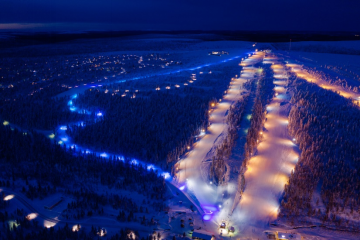
二、自然地理
1.地理条件
North of Inari by the main road E75, lies the village of Kaamanen. It is a traditional meeting point as from there the roads and snowmobile tracks lead to North, East, South and West. To the North lies Utsjoki, to the West Karigasniemi and Sevettijärvi and Näätämö are located in the East. Finnish Lapland, especially its northern tip on the Norwegian border, was the warmest part of the country on both Monday and Tuesday. Besides Kevo, the FMI says Ivalo Airport and Kaamanen village in Inari both had readings of 27.9 degrees, with Nellim and Angeli Lintupuoliselkä, both also in Inari, just behind at 27.8 and 27.4.
Kaamanen, named after the reindeer's leggings, gámas, is a village of two hundred inhabitants on four roads, 1,200 kilometers north of Helsinki. In its inn, reindeer herding and inari whitefish are eaten with A-licenses, and once a year the grieving Gámas Blues plays there. The window opens onto the Kaamasjoki River and the Muotkatunturi wilderness spreads to the west.
2. 交通情况
Inari-Saariselkä is far away in the North and yet just a few hours from southern Finland and Europe. Lapland is well connected to the world through flights, highways and railways combined with bus connections. Kaamanen is located in the northernmost part of Finland, next to the Kielajoki River and 92nd National Highway. You can reach Nordkapp in 4 hours by car from the 92nd highway. Ivalo Airport is 120 km away and Giellajohka, and most of the accommodation provides a shuttle service upon request.
三、经济发展和规模
The GDP of Kaamanen village contributes to the area of Lapland region. The GDP of Lapland region is around 6348 million Euro and 6982 million US dollars.
One of the big company around Kaamanen area is Tmi Sanna-Mari Vesanen, located in Lappi, Finland. It is part of the Direct Selling Industry. Tmi Sanna-Mari Vesanen has employees across all of its locations. There are companies in the Tmi Sanna-Mari Vesanen corporate family. The Tmi Sanna-Mari Vesanen Company has around 0.079202million dollars sales revenue.
四、产业特点/重点项目
The most important economic part in Kaamanen is tourism each year. In addition, the village counts about 200 inhabitants, whose main sources of livelihood are reindeer husbandry and tourism. The main livelihoods of the village are reindeer husbandry and service industries.The area is extremely valuable for bird-watchers and there are relatively important hiking paths.
Kaamanen has a strong fishing and wilderness culture. In River Kaamanen and other surrounding fishing waters, brown trout and grayling are caught. The area is known for its extensive wild fowl population and is said to be the paradise for the bird photographers.
There are many great summer excursion destinations in the Kaamanen region: the Tuuruharju nature trail, Muddusjärvi nature trail with its campfire sites and the Sulaoja trail, which revolves around Finland's largest spring. The trails instantly introduce the walker to the finest views of the area.
五、风景名胜,景点( attractions)
1. Lake Inari
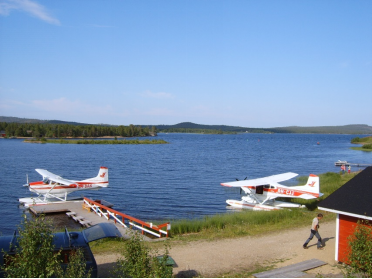
Lake Inari is the largest lake in Sápmi and the third-largest lake in Finland. It is located in the northern part of Lapland, north of the Arctic Circle. The lake is 117–119 metres above sea level, and is regulated at the Kaitakoski power plant in Russia. The freezing period normally extends from November to early June. The best-known islands of the lake are Hautuumaasaari ("Graveyard Island"), which served as a cemetery for ancient Sami people, and Ukonkivi ("Ukko's Stone"), a historical sacrifice place of the ancient inhabitants of the area. There are over 3,000 islands in total. Trout, lake salmon, Arctic char, white fish, grayling, perch and pike are found in Lake Inari.
2. Siida
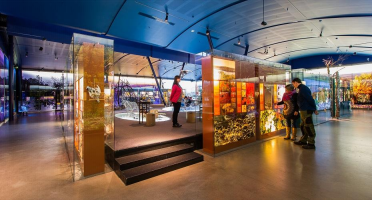
The siida is a Sami local community that has existed from time immemorial. A siida (in different Sami languages cearru, siida, sita, kite), or a "reindeer pastoralistic district," is a Sami reindeer foraging area, a group for reindeer herding and a corporation working for the economic benefit of its members. The reindeer herding siida has formed as an adaptation of ancient siida principles to large-scale nomadic reindeer herding. It is termed a sameby ("Sami village") in Swedish law, reinbeitedistrikt ("reindeer pasture district") in Norwegian law, and paliskunta in Finnish law. The pastoralistic organisation differs slightly between countries, except in Russia, where kolkhoz has replaced these earlier organisations.
3. Lemmenjoki National Park
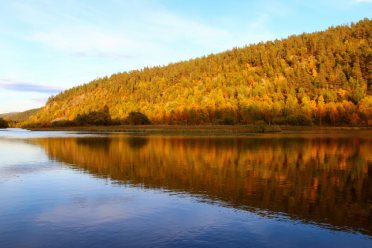
Lemmenjoki National Park is situated in area of municipalities of Inari and Kittilä, Lapland, in Northern Finland. It was founded in 1956 and has since been expanded twice. Its total area is 2,850 square kilometres (1,100 sq mi), making it the biggest national park of Finland and one of the largest in Europe.
The park is named after the Lemmenjoki River, an 80 kilometres (50 mi) long river running through it.
The park is partly bordered by the Øvre Anarjóhka National Park in Norway.
Around 100 people can be seen digging gold in the area in the summer on 40 claims. Most of the people in the park – around 10,000 people per year – are backpackers, though. There are about 60 kilometres (40 mi) marked paths in the national park, and even some bridges and boats are put up for travelers. There are more than ten free wilderness huts in the park and three chargeable, bookable ones.
4. Pielpajarvi Wilderness Church
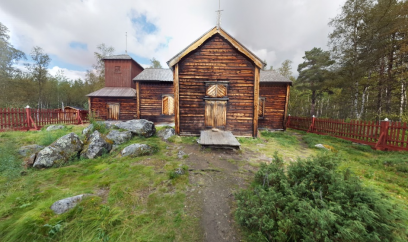
Sitting by a lakeshore surrounded by a birch forest, Pielpajarvi Wilderness Church represents one of the oldest buildings in northern Lapland. Built in 1760 on the site of an old Sami winter village, the wooden church remains in a surprisingly good condition given the fact that it sits largely abandoned, except for a yearly midsummer ceremony. Its doors remain unlocked all year round, welcoming all travelers. Amenities include functional restrooms and huts where you can warm up by the fire and make a cup of tea. The church can be accessed by hiking from the bay or from Inari village. Work out when and for how long to visit Pielpajarvi Wilderness Church and other Inari attractions using our handy Inari day trip planning tool.
5. Lake Menesjarvi
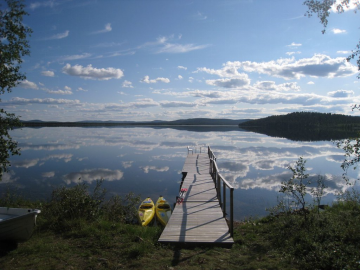
Lake Menesjärvi is an ideal small lake for canoeing and kayaking. Lake is easy also for beginners and you can do water activities independently. We also recommend trying rowing boat which is Finnish people number one choice. Rowing boat is ideal for lakes and is commonly used in Finland which is famous for having thousands of lakes.
六、历史文化
1.历史
Kaamanen was the center of the municipality of Inari in the early 20th century. The northernmost barley in Finland was grown here, and Thule Guesthouse was known all the way to southern Finland. As late as the 1950s, people traveled to the village on reindeer tracks, although the Germans had already built a road to Norway via Karigasniemi during the war years. Buses to Utsjoki started running in 1959.
The villages of Inari, such as Kaamanen, are the heart of the Sámi culture in Finland. Vibrant Sámi culture is visible in everyday life and visitors are invited to explore the culture with local, Sámi-run companies. Why not experience the old traditional Sámi way of travelling and hop on a sleigh pulled by reindeer? The culture and languages are kept alive also through education, as it is possible to study all three of Finland’s Sámi languages, traditional handicrafts and reindeer husbandry in Inari’s Sámi Educational Institute. Sámi Museum and Nature Centre Siida is a must-see while travelling in Inari. The location right by the mighty Lake Inari allows adventures on the lake by boat in the summertime and by snowmobile in wintertime. Inari is also an excellent location to see the Northern Lights, as it is situated right under the Aurora oval.
2. 文化
All villages have their unique character – in Lemmenjoki you find Finland’s largest National Park and Nellim and Sevettijärvi will teach you a thing or two about Skolt Sámi culture.
Kaamanen has a strong fishing and wilderness culture. In River Kaamanen and other surrounding fishing waters, brown trout and grayling are caught. The area is known for its extensive wild fowl population and is said to be the paradise for the bird photographers.
Kaamanen's inn hosts an annual music event called Gámas-Blues. The event will also spread to the church village of Inari. The background of the event is Jarmo Siivikko, a municipal politician and musician from Inari. In 2008, the event featured English blues musician Papa George, among others.
七、其他信息
Inari-Saariselkä is a vast area in northernmost Finnish Lapland, with many exciting destinations and sights within. Get to know the different villages of the northern region – from the outdoor resort of Saariselkä to the centre of Sámi culture in Inari, and on to the northernmost tip of EU in Nuorgam.
The Village of four winds: Four is a symbolic number for Kaamanen. This little Inari Sámi village is known as the borderland of four tribes and the crossroads of four important roads. Indeed, Kaamanen is a rendezvous point offering road and snowmobile route connections north, east, south and west. Kaamanen has a strong fishing and hunting culture. Trout and grayling migrate along the Kaamasjoki River and other waterways in the region. Abundant with wild fowl, the district is internationally renowned among ornithologists and the area has received praise from bird photographers as being a dream location. At the feeding spots in Kaamanen, you can sport many species of Arctic birds, and the chances of spotting these species elsewhere are very slim. The wilderness district of the Muotkatunturi fell highland opening up to the west of Kaamanen does not have any marked hiking trails, but the more experienced hiker will be able to enjoy the most beautiful landscapes with fells and winding rivers
八、联系方式
Mayor of Inari (including the villages in Inari): Toni K. Laine
Website: http://www.kaamanen.fi/index.php/fi/
Email: marja.kumpuniemi (a) inarisaariselka.fi
Phone number: +358 16 672713
